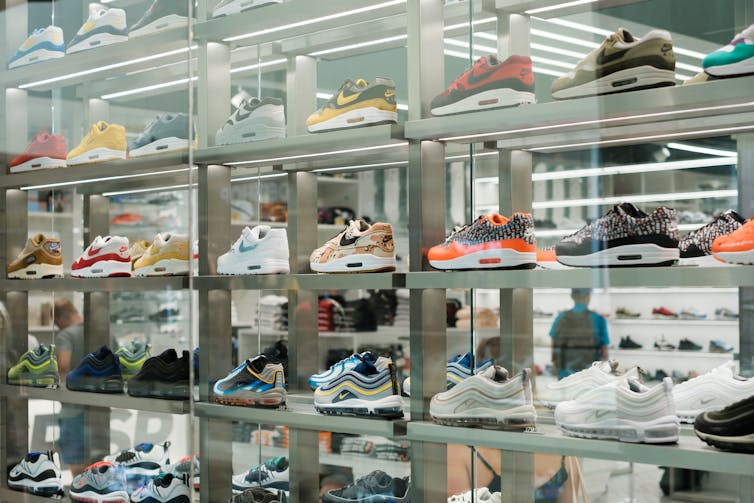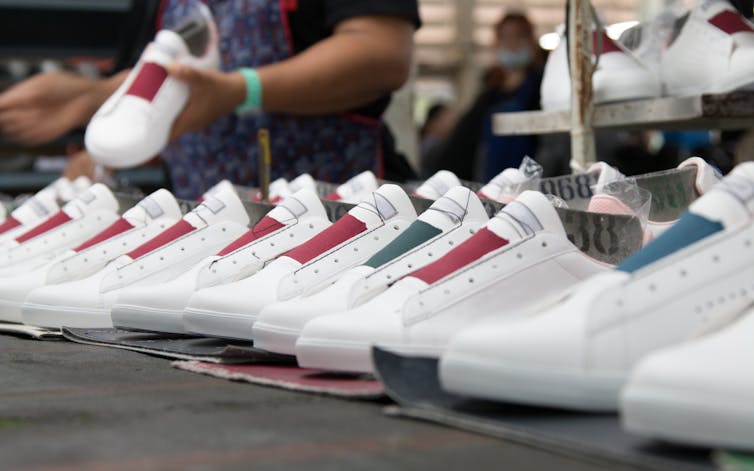Designer fashion, nostalgia magnet - what's behind the rise and rise of the sneaker?
- Written by Emily Brayshaw, Lecturer, Fashion and Design History, Theory, and Thinking, University of Technology Sydney
In June this year, hundreds of Australian shoppers queued – some overnight – to buy a pair of Yeezy Boost 350 V2 Black Static Adidas sneakers the moment they went on sale. Before lining up, customers had to register and go into a draw to determine whether they could buy a pair. The shoes sold for a few hundred dollars but are now being traded for up to A$3000.
This quest to obtain limited edition sneakers designed by rapper Kanye West is not an isolated phenomenon. People have long gone to extreme lengths to get their hands on the latest kicks.
There have been reports of sneaker violence since the 1980s.
For those wishing to form a more orderly queue, the internet has responded with news services and dedicated message boards to help people get the latest kicks. Other sites treat sneakers like stock market commodities.
But how does society’s sneaker love tally with our awareness of the environmental and human cost of consumerism?
 Prized sneaker specimens on display.
www.shutterstock.com
Prized sneaker specimens on display.
www.shutterstock.com
A brief history
The first sneakers appeared in 1830s England, when Liverpool Rubber bonded a canvas outer onto a vulcanised rubber sole, creating the original sand shoe for the Victorian middle classes to wear on the beach.
Different styles of the shoe were developed in the UK and the US throughout the 19th century to respond to athletic pursuits like running, tennis, jumping and sailing. The term “sneaker” was coined in the US in the 1870 to describe the shoe because it was noiseless. Athletes in Paris wore sneakers at the first modern Olympic Games in 1900.
The American pro-basketball player Charles H. Taylor, passionately promoted the sneakers designed by Marquis M. Converse in 1917. By 1923, Taylor’s improvements had been incorporated into the shoe, his signature added to their design, and Converse “Chucks” have remained unchanged since.
 Classic and well-loved ‘Chucks’ Converse.
www.shutterstock.com
Classic and well-loved ‘Chucks’ Converse.
www.shutterstock.com
Adidas was founded by the Dassler brothers in Germany in 1926, and Puma was founded in 1948 when the Dassler brothers split. Onitsuka Tiger (ASICS) were founded in Japan in 1949 and Reebok started making sneakers in 1958. New Balance started creating their “Trackster” sneakers in 1961, and Nike was founded in 1972. At every point, sneakers were created to support athletes, but also to promote lifestyles that connected leisure with physical activity.
Since the 1970s, sneakers have been linked to skateboarding and hip-hop culture, including break dancing; urban pursuits that require a high degree of comfort and ease of movement. The explosion of hip-hop from the mid-1980s and its global dominance in the 1990s meant that sneakers quickly became a visual symbol of hip-hop and a symbol of its separation from the mainstream.
Run DMC’s 1986 track, My Adidas was as much about the band’s love for sneakers as it was about how quickly people judged black youth who wore sneakers to be troublemakers.
Sneaker love grew with the rise of hip-hop music.Likewise, when rave culture blossomed in the 1980s and 1990s, sneakers became the footwear of choice for the 24-hour party people who dressed to sweat.
Sneakers today
The current nostalgia in sneakers extends to design imagery, styles, and colour combinations. In April this year, Adidas issued a limited edition version of the My Adidas Superstar 1986 sneaker.
 Balenciaga sneakers at Paris Fashion Week.
www.shutterstock.com
Balenciaga sneakers at Paris Fashion Week.
www.shutterstock.com
Luxury brands have also taken note, capitalising on historical references, status concerns and a relaxation in social dress codes.
Leading high-fashion brands, including Chanel, Louis Vuitton and Balenciaga now consider sneakers a must-have fashion item in their collections.
Balenciaga’s recent Triple S sneakers (priced at around A$1300) echo the platform sneaker trends of the 1990s, with the company’s CEO Cédric Charbit, noting “sneakers … blend nicely with the way we live”.
Where once 1980s women swapped their commuter sneakers for power heels at the office, people now wear their sneakers all day.
Charbit believes the sneaker has become, “very versatile, it goes from day to night, it goes for the weekend, it goes for work”.
Sustainability and ethical production
While many sneaker fans continue to prioritise style over environmental concerns, others are demanding transparency around the ethics and impact of production, leading to the rise of the sustainable sneaker.
Meghan, The Duchess of Sussex, favours Veja sneakers made from wild Amazonian rainforest rubber.
Adidas has been making sneakers using recycled ocean plastic since 2015, but says it wants to go further. It launched the Futurecraft Loop in April, a sneaker made exclusively from 100% reusable Thermoplastic polyurethane that can be recycled again and again.
 The reality of sneaker production is less glamorous - but shopping guides can inform ethical choices.
www.shutterstock.com
The reality of sneaker production is less glamorous - but shopping guides can inform ethical choices.
www.shutterstock.com
Adidas, Brooks, Reebok, and Salomon showed positive working conditions at their factories in a 2018 survey, but there was still a problem with low wages.
Read more: Sustainable shopping: how to rock white sneakers without eco-guilt
Sites like the Good Shopping Guide can help customers can make more informed choices. But sustainable fashion expert Mark Liu notes, “Sneakers are still extremely problematic because of all their toxic petrochemical components, glues and the amount of greenwash in the industry”.
Sneakerium by Parisian artist Christophe Guinet, aka Monsieur Plant.Supply and demand
One key to enduring sneaker love is scarcity. Adidas only released 1986 of their limited-edition My Adidas Superstar 1986 shoes. West also generates exclusivity with low production numbers – only 40,000 pairs of Yeezys are made worldwide for each drop and shops in Australia may only have 25 pairs of each incarnation.
 Kylie Jenner spruiks Adidas Originals.
AAP
Kylie Jenner spruiks Adidas Originals.
AAP
The combination of rarity, and the myriad cultural meanings embedded in sneakers creates an emotional pull for collectors like DJ Jerome Salele’a that ties them to sneaker, hip-hop, skater and rave communities around the globe.
The ultimate sneaker is a comfortable vehicle for the body to move through the world that expresses the wearer’s desires, dreams and aspirations and crosses social, geographic and language boundaries.
Authors: Emily Brayshaw, Lecturer, Fashion and Design History, Theory, and Thinking, University of Technology Sydney



